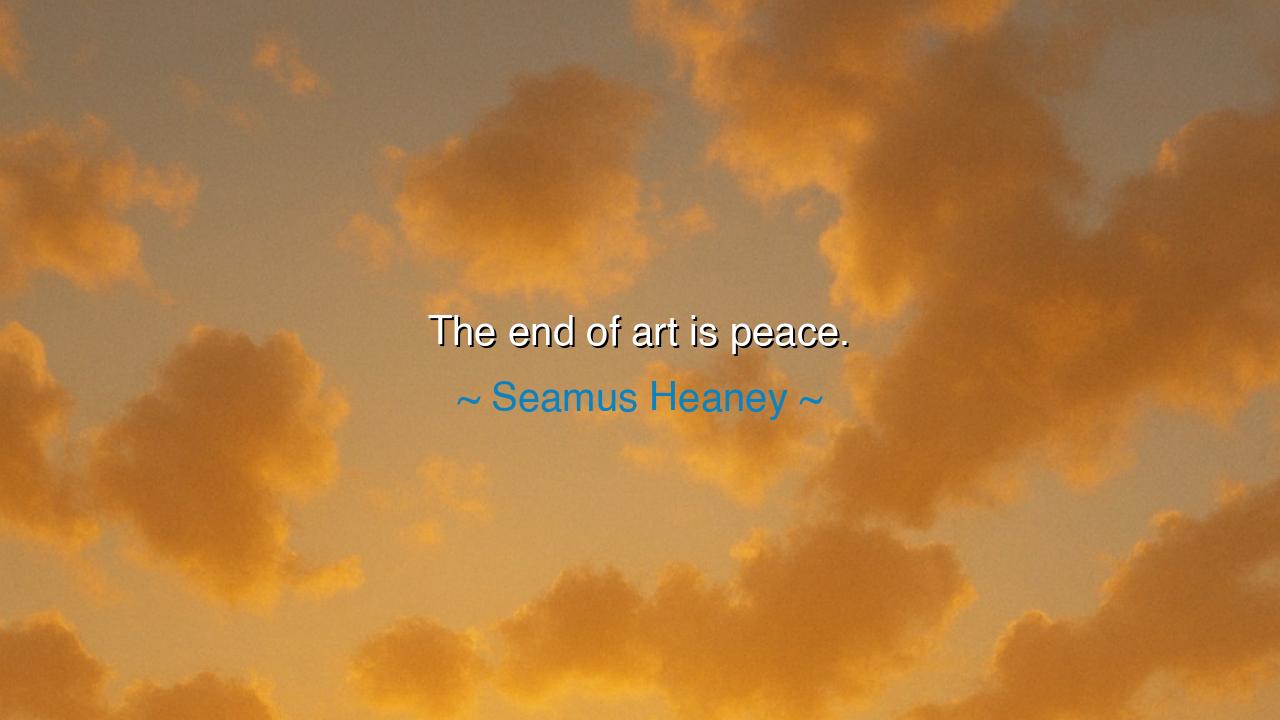
The end of art is peace.






Hear the words of Seamus Heaney, poet of Ireland, whose verses carried both the grief of history and the balm of hope: “The end of art is peace.” This phrase is no idle ornament, but the distilled wisdom of a man who lived amidst the struggles of his divided homeland, yet sought to transform violence and bitterness into beauty and reconciliation. Heaney’s declaration stands as both prophecy and command: that the highest aim of creation is not chaos, nor spectacle, nor vanity, but harmony—an inner and outer peace born from truth expressed with courage.
The meaning of this line runs deep. Art—whether in word, in song, in painting, or in stone—often begins in conflict. The artist wrestles with sorrow, with longing, with injustice, with the unbearable weight of existence. Yet when shaped into form, these struggles are transfigured. What begins as turmoil finds its resolution, and what begins as a cry becomes a hymn. Thus Heaney teaches us that the final goal of all art is not to leave us torn, but to bring us to rest; not to ignite endless discord, but to guide us toward understanding. In this sense, the end of art is not only peace of society, but peace of the soul.
The origin of Heaney’s words lies in his Nobel Lecture of 1995, when he spoke from the long shadows of the Troubles, that bitter conflict which scarred Northern Ireland for decades. He knew intimately the power of words, for words had been used both to divide and to heal his people. To proclaim that “the end of art is peace” was to remind his listeners that poetry and storytelling were not weapons of destruction, but instruments of reconciliation. The poet, like the peacemaker, labors to bridge chasms, to uncover shared humanity, to restore what violence has broken.
History confirms this truth in many places. Consider the music of Beethoven, composed in the turmoil of Europe’s wars. His Ninth Symphony, rising in its final movement to the Ode to Joy, has become a hymn not of victory in battle, but of universal brotherhood. Though born of a storm-tossed age, his art reached beyond conflict to proclaim a vision of peace. Likewise, Picasso’s Guernica, though depicting horror, became a cry for reconciliation—a reminder of suffering, yet also a path toward the longing for harmony. Both works prove Heaney’s claim: that true art does not end in violence, but in peace.
And what of words? Consider Martin Luther King Jr., whose speeches were not dry arguments but works of art, soaring with rhythm and imagery. He spoke in the midst of hatred and brutality, yet his words, deeply poetic, carried the vision of a world at peace. His art of speech gave courage to the oppressed and pricked the conscience of the oppressors. Though he suffered violence, the artistic power of his words became seeds of peace that still grow today. This is the very work Heaney envisions: art as the midwife of reconciliation.
The lesson for us is radiant. When you create—whether through writing, through music, through building, through living—ask yourself: does this lead toward peace? Do my words heal, or do they wound? Do my creations foster harmony, or do they fuel discord? To live as an artist, in Heaney’s vision, is not only to produce beauty but to cultivate reconciliation wherever you stand. Every person has the power to shape their daily actions into art, and thus, into peace.
Therefore, beloved seeker of wisdom, embrace this truth: let your art, however humble, aim toward peace. In your family, let your words be poetry of kindness. In your work, let your efforts be architecture of harmony. In your community, let your presence be music of reconciliation. For if art ends in peace, then every life, lived as art, can become a wellspring of peace for the world.
So remember always the words of Heaney: “The end of art is peace.” Not destruction, not division, not vanity, but peace. Strive to make of your life a masterpiece that ends not in discord, but in harmony—a legacy of calm, of truth, and of reconciliation for generations yet to come.






AAdministratorAdministrator
Welcome, honored guests. Please leave a comment, we will respond soon